Increase or Decrease? The Impact of Land Development Rights Transfer on Regional Carbon Emission Governance
Abstract
1. Introduction
2. Theoretical Research Framework
3. Data and Methodology
3.1. Overview of the Study Area
3.2. Data Sources and Processing
3.3. Research Methodology
3.3.1. MSPA Model
3.3.2. Prediction of Land-Use Patterns Based on the PLUS Model
- (1)
- PLUS Model
- (2)
- PLUS Model Scenario Setting
3.3.3. Calculation of Carbon Emissions from Land Use
3.3.4. Fossil Energy Consumption Forecasting
4. Analysis of Results
4.1. Analysis of Land-Use Change
4.2. Analysis of the Spatial and Temporal Evolution of Carbon Emissions
4.2.1. Spatial and Temporal Evolution of Carbon Emissions in Guangxi
4.2.2. Spatial and Temporal Evolution of Carbon Emissions in Guangxi Cities
5. Conclusions and Discussion
5.1. Discussion
5.1.1. Impact of Policies on the Transfer of Land Development Rights
5.1.2. Trade-Offs in Low-Carbon Land Use in China
5.1.3. Research Limitations and Prospects
5.2. Conclusions
Author Contributions
Funding
Institutional Review Board Statement
Informed Consent Statement
Data Availability Statement
Conflicts of Interest
References
- Nguyen, D.K.; Huynh, T.L.D.; Nasir, M.A. Carbon emissions determinants and forecasting: Evidence from G6 countries. J. Environ. Manag. 2021, 285, 11198. [Google Scholar] [CrossRef]
- Wang, R.; Xie, S.; Zhang, C.; Xu, Q.; Tian, X. Emission drivers of cities at different industrialization phases in China. J. Environ. Manag. 2019, 250, 109494. [Google Scholar] [CrossRef]
- Searchinger, T.D.; Edwards, R.; Mulligan, D.; Heimlich, R.; Plevin, R.; Wendell, D.; Malins, C.; Halvorson, L. Assessing the efficiency of changes in land use for mitigating climate change. Nature 2018, 564, 249–253. [Google Scholar] [CrossRef] [PubMed]
- Houghton, R.A.; Nassikas, A.A. Global and regional fluxes of carbon from land use and land cover change 1850–2015. Glob. Biogeochem. Cycles 2017, 31, 456–472. [Google Scholar] [CrossRef]
- Meng, Q.; Zheng, Y.; Liu, Q.; Li, B.; Wei, H. Analysis of spatiotemporal variation and influencing factors of land-use carbon emissions in nine provinces of the yellow river basin based on the LMDI model. Land 2023, 12, 437. [Google Scholar] [CrossRef]
- Zhu, W.; Lan, T.; Tang, L. Impacts of Future Climate Change and Xamen’s Territorial Spatial Planning on Carbon Storage and Sequestration. Remote Sens. 2025, 17, 273. [Google Scholar] [CrossRef]
- Fryer, J.; Williams, I.D. Regional carbon stock assessment and the potential effects of land cover change. Sci. Total Environ. 2021, 775, 145815. [Google Scholar] [CrossRef]
- Shan, W.; Yang, X.; Gu, Z.; Xiao, X. A framework for assessing carbon effect of land consolidation with life cycle assessment: A case study in China. J. Environ. Manag. 2020, 266, 110557. [Google Scholar] [CrossRef]
- Tang, X.; Woodcock, C.E.; Olofsson, P.; Hutyra, L.R. Spatio-temporal assessment of land use/land cover change and associated carbon emissions and uptake in the Mekong River Basin. Remote Sens. Environ. 2021, 256, 112336. [Google Scholar] [CrossRef]
- Ke, Y.; Xia, L.; Huang, Y.; Li, S.; Zhang, Y.; Liang, S.; Yang, Z. The carbon emissions related to the land-use changes from 2000 to 2015 in Shenzhen, China: Implication for exploring low-carbon development in megacities. J. Environ. Manag. 2022, 319, 115660. [Google Scholar] [CrossRef]
- Wang, G.; Han, Q. The multi-objective spatial optimization of urban land use based on low-carbon city planning. Ecol. Indic. 2021, 125, 107540. [Google Scholar] [CrossRef]
- Li, L.; Huang, X.; Yang, H. Optimizing land use patterns to improve the contribution of land use planning to carbon neutrality target. Land Use Policy 2023, 135, 106959. [Google Scholar] [CrossRef]
- Xia, C.; Zhang, J.; Zhao, J.; Xue, F.; Li, Q.; Fang, K.; Shao, Z.; Li, S.; Zhou, J. Exploring potential of urban land-use management on carbon emissions—A case of Hangzhou, China. Ecol. Indic. 2023, 146, 109902. [Google Scholar] [CrossRef]
- Zhang, W.; Xu, H. Effects of land urbanization and land finance on carbon emissions: A panel data analysis for Chinese provinces. Land Use Policy 2017, 63, 493–500. [Google Scholar] [CrossRef]
- Zheng, B.; Liang, H.; Wan, W.; Liu, Z.; Zhu, J.; Wu, Z. Spatial-temporal patterns and influencing factors of agricultural carbon emissions in Jiangxi Province. Trans. Chin. Soc. Agric. Eng. 2022, 38, 70–80. [Google Scholar] [CrossRef]
- Li, X.; Li, Z.; Xie, X.; Liu, X.; Chen, J.; Li, Y. Interactive mechanisms of urbanization, carbon emissions, and “three living spaces” in Henan Province. Trans. Chin. Soc. Agric. Eng. 2023, 39, 256–265. [Google Scholar] [CrossRef]
- Kais, S.; Hammami, S. An econometric study of the impact of economic growth and energy use on carbon emissions: Panel data evidence from fifty-eight countries. Renew. Sustain. Energy Rev. 2016, 59, 1101–1110. [Google Scholar] [CrossRef]
- Zhou, Y.; Chen, M.; Tang, Z.; Mei, Z. Urbanization, land use change, and carbon emissions: Quantitative assessments for city-level carbon emissions in Beijing-Tianjin-Hebei region. Sustain. Cities Soc. 2021, 66, 102701. [Google Scholar] [CrossRef]
- Wang, H.; Lu, S.; Lu, B.; Nie, X. Overt and covert: The relationship between the transfer of land development rights and carbon emissions. Land Use Policy 2021, 108, 105665. [Google Scholar] [CrossRef]
- Marques-Carvalho, R.; Almeida, C.M.d.; Escobar-Silva, E.V.; Oliveira Alves, R.B.d.; Anjos Lacerda, C.S.d. Simulation and Prediction of Urban Land Use Change Considering Multiple Classes and Transitions by Means of Random Change Allocation Algorithms. Remote Sens. 2023, 15, 90. [Google Scholar] [CrossRef]
- Chen, Y.; Zhang, F.; Lin, J. Projecting Future Land Use Evolution and Its Effect on Spatiotemporal Patterns of Habitat Quality in China. Appl. Sci. 2025, 15, 1042. [Google Scholar] [CrossRef]
- Liu, X.; Guan, Q.; Clarke, K. Understanding the drivers of sustainable land expansion using a patch-generating land use simulation (PLUS) model: A case study in Wuhan, China. Comput. Environ. Urban Syst. 2021, 85, 101569. [Google Scholar] [CrossRef]
- Zhang, Z.; Hu, B.; Jiang, W. Spatial and temporal variation and prediction of ecological carrying capacity based on machine learning and PLUS model. Ecol. Indic. 2023, 154, 110611. [Google Scholar] [CrossRef]
- Peng, L.; Wang, L.; Xia, D.; Gao, Q. Effective energy consumption forecasting using empirical wavelet transform and long short-term memory. Energy 2022, 238, 121756. [Google Scholar] [CrossRef]
- Wang, M.; Wang, W.; Wu, L. Application of a new grey multivariate forecasting model in the forecasting of energy consumption in 7 regions of China. Energy 2022, 243, 123024. [Google Scholar] [CrossRef]
- Wang, J.; Du, Y.; Wang, J. LSTM based long-term energy consumption prediction with periodicity. Energy 2020, 197, 117197. [Google Scholar] [CrossRef]
- Liu, Z.; Huang, Y.; Zhang, S.; Luo, X.; Chen, X.; Lin, J.; Tang, Y.; Guo, L.; Li, J. A collaborative interaction gate-based deep learning model with optimal bandwidth adjustment strategies for lithium-ion battery capacity point-interval forecasting. Appl. Energy 2025, 377, 124741. [Google Scholar] [CrossRef]
- Xu, Q.; Yang, R.; Dong, Y.-X.; Liu, Y.-X.; Qiu, L.-R. The influence of rapid urbanization and land use changes on terrestrial carbon sources/sinks in Guangzhou, China. Ecol. Indic. 2016, 70, 304–316. [Google Scholar] [CrossRef]
- Wang, H.; He, C.; Li, W.; Nie, X.; Zhong, H.; Wen, L. Will transferable development rights (TDR) increase regional economic imbalance?—A quota transaction case of cultivated land conversion and reclamation in Guangxi, China. Habitat Int. 2020, 104, 102254. [Google Scholar] [CrossRef]
- Chapin, T. Introduction: From growth controls, to comprehensive planning, to smart growth: Planning’s emerging fourth wave. J. Am. Plan. Assoc. 2012, 78, 5–15. [Google Scholar] [CrossRef]
- Chen, C.; Li, Y.; Charles, L.; Wang, X. “Dipiao,” Chinese approach to transfer of land development rights: The experiences of Chongqing. Land Use Policy 2020, 99, 104870. [Google Scholar] [CrossRef]
- Nie, X.; Li, X.; Lyu, C.; Su, Y.; Wang, H. Can ecological compensation based on the transfer of development rights (TDR) improve ecosystem service value? A multi-scenario simulation. Land Use Policy 2024, 138, 107024. [Google Scholar] [CrossRef]
- Wang, B.; Li, F.; Feng, S.; Shen, T. Transfer of development rights, farmland preservation, and economic growth: A case study of Chongqing’s land quotas trading program. Land Use Policy 2020, 95, 104611. [Google Scholar]
- Tan, R.; Beckmann, V.; Qu, F.; Wu, C. Governing farmland conversion for urban development from the perspective of transaction cost economics. Urban Stud. 2012, 49, 2265–2283. [Google Scholar] [CrossRef]
- Yu, J.; Shen, K. The allocation logic of urban construction land quotas and its impact on the housing market. Econ. Res. J. 2019, 54, 116–132. [Google Scholar]
- Ma, B.; Tian, G.; Kong, L.; Liu, X. How China’s linked urban–rural construction land policy impacts rural landscape patterns: A simulation study in Tian, China. Landsc. Ecol. 2018, 33, 1417–1434. [Google Scholar] [CrossRef]
- Lin, J.; Huang, C.; Wen, Y.; Liu, X. An assessment framework for improving protected areas based on morphological spatial pattern analysis and graph-based indicators. Ecol. Indic. 2021, 130, 108138. [Google Scholar] [CrossRef]
- Yang, X.; Chen, X.; Che, L.; Qiao, F.; Pu, L. Functional optimization of land use in the Lanzhou-Xining urban agglomeration integrating ecological security. Acta Ecol. Sin. 2023, 43, 2583–2593. [Google Scholar] [CrossRef]
- Yang, Y.; Wang, H.; Li, X.; Huang, X.; Lyu, X.; Tian, H.; Qu, T. How will ecosystem carbon sequestration contribute to the reduction of regional carbon emissions in the future? Analysis based on the MOP-PLUS model framework. Ecol. Indic. 2023, 156, 111156. [Google Scholar] [CrossRef]
- Men, D.; Pan, J. Ecological network identification and connectivity robustness evaluation in the Yellow River Basin under a multi-scenario simulation. Ecol. Model. 2023, 482, 110384. [Google Scholar] [CrossRef]
- Song, M.; Yi, L.; Zhang, A. Multi-scenario measurement of the restricted development rights of land under planning regulation: Quantity and value. Chin. Popul. Resour. Environ. 2022, 32, 107–115. [Google Scholar]
- Liu, S.; Xiao, W.; Ye, Y.; He, T.; Luo, H. Rural residential land expansion and its impacts on cultivated land in China between 1990 and 2020. Land Use Policy 2023, 132, 106816. [Google Scholar] [CrossRef]
- Sun, H.; Liang, H.; Chang, X.; Cui, Q.; Tao, Y. Carbon emissions and spatial correlations of land use in China. Econ. Geogr. 2015, 35, 154–162. [Google Scholar] [CrossRef]
- Lai, L. Research on the Carbon Emission Effects of Land Use in China. Ph.D. Dissertation, Nanjing University, Nanjing, China, 2011. [Google Scholar]
- Piao, S.; Fang, J.; Huang, Y. Carbon balance of terrestrial ecosystems in China. Basic Sci. China 2010, 12, 20–22+65. [Google Scholar] [CrossRef]
- Su, J.; Li, G.; Zhang, X. GCN-LSTM model integrating spatiotemporal features for dust weather prediction in Northwest China. J. Arid Land Resour. Environ. 2024, 38, 111–120. [Google Scholar] [CrossRef]
- Shen, Y.; Guo, Q.; Liu, Z.; Shen, Y.; Jia, Y.; Wei, Y. Prediction of drought-flood prone zones in inland mountainous regions under climate change with assessment and enhancement strategies for disaster resilience in high-standard farmland. Agric. Water Manag. 2025, 309, 109349. [Google Scholar] [CrossRef]
- Pruetz, R.; Standridge, N. What makes transfer of development rights work?: Success factors from research and practice. J. Am. Plan. Assoc. 2008, 75, 78–87. [Google Scholar] [CrossRef]
- Kan, K. Creating land markets for rural revitalization: Land transfer, property rights and gentrification in China. J. Rural Stud. 2021, 81, 68–77. [Google Scholar] [CrossRef]
- Jin, X.; Ying, S. Adaptation and path optimization of comprehensive land remediation for regional high-quality development. Chin. Land Sci. 2023, 37, 1–11. [Google Scholar]
- Lebel, L.; Garden, P.; Banaticla, M.R.N.; Lasco, R.D.; Contreras, A.; Mitra, A.P.; Sharma, C.; Nguyen, H.T.; Ooi, G.L.; Sari, A. Integrating carbon management into the development strategies of urbanizing regions in Asia. J. Ind. Ecol. 2007, 2, 61–81. [Google Scholar] [CrossRef]
- Pei, J.; Niu, Z.; Wang, L.; Song, X.-P.; Huang, N.; Geng, J.; Wu, Y.-B.; Jiang, H.-H. Spatial-temporal dynamics of carbon emissions and carbon sinks in economically developed areas of China: A case study of Guangdong Province. Sci. Rep. 2018, 13383. [Google Scholar] [CrossRef]
- Brinck, K.; Fischer, R.; Groeneveld, J.; Lehmann, S.; De Paula, M.D.; Pütz, S.; Sexton, J.O.; Song, D.; Huth, A. High resolution analysis of tropical forest fragmentation and its impact on the global carbon cycle. Nat. Commun. 2017, 8, 14855. [Google Scholar] [CrossRef]
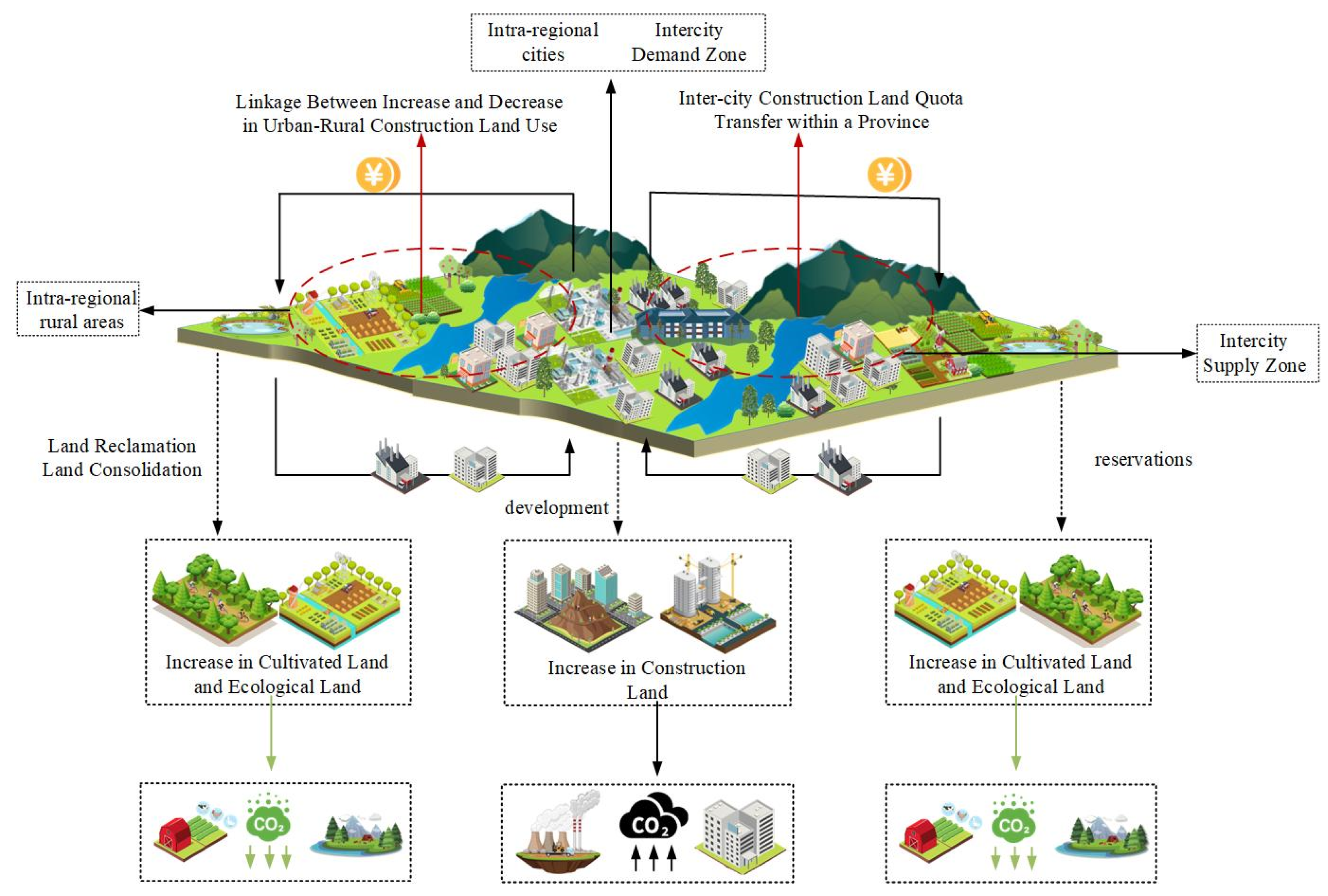
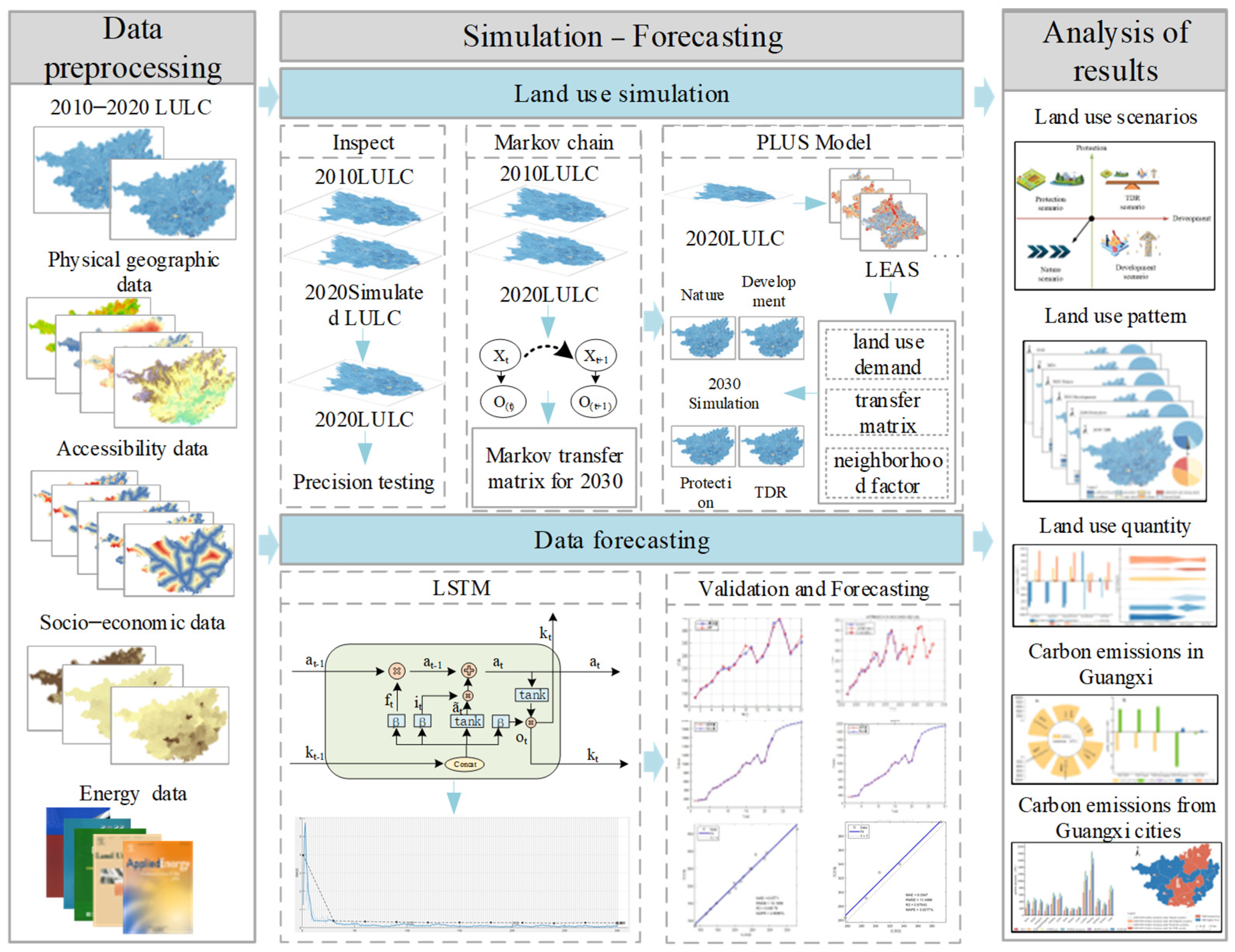
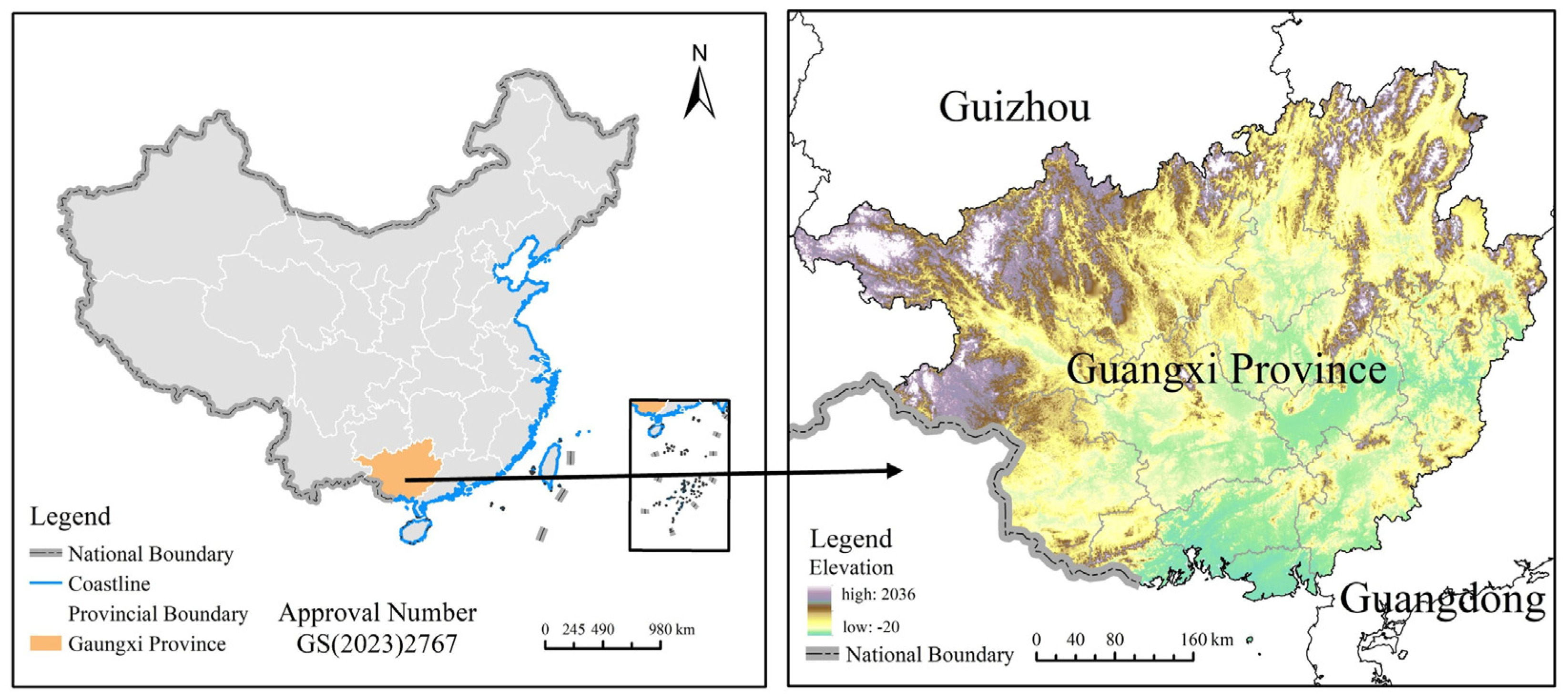



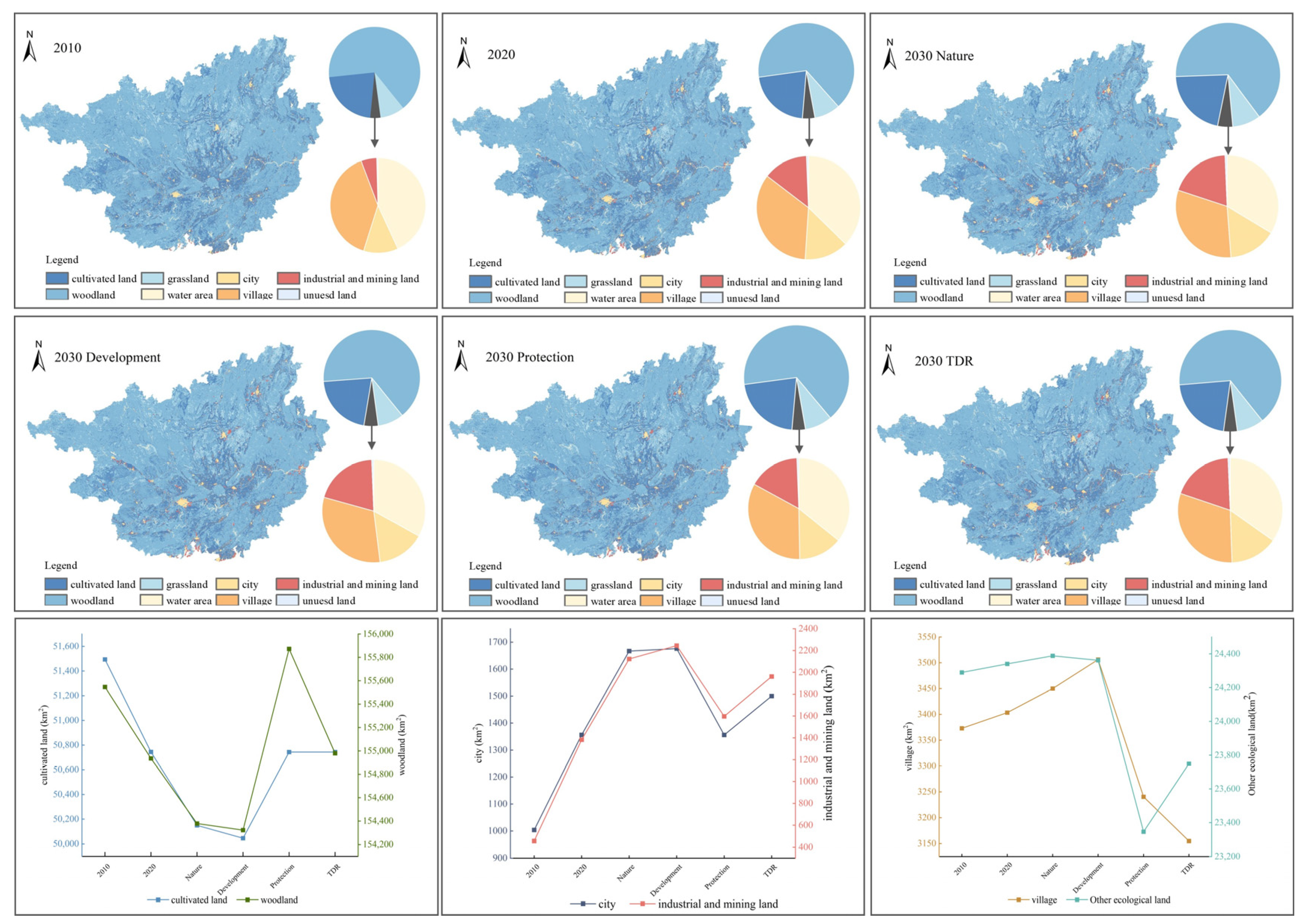
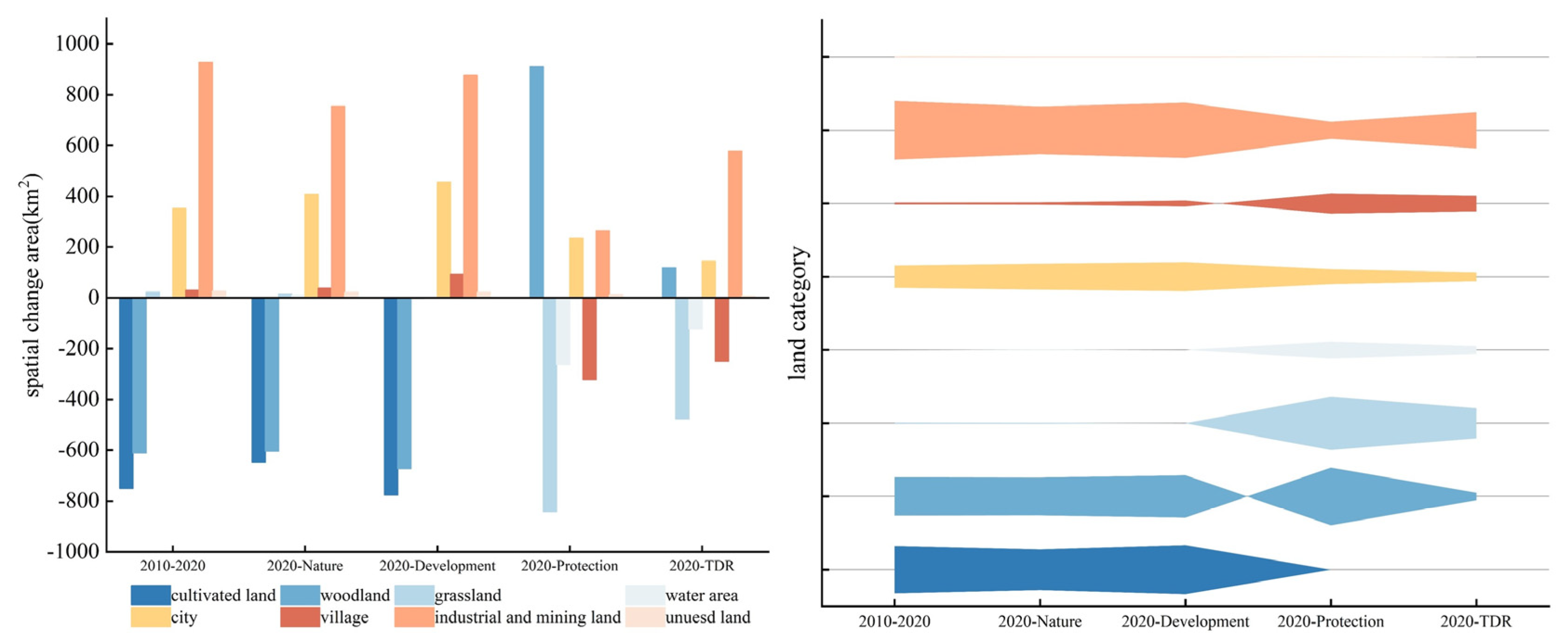
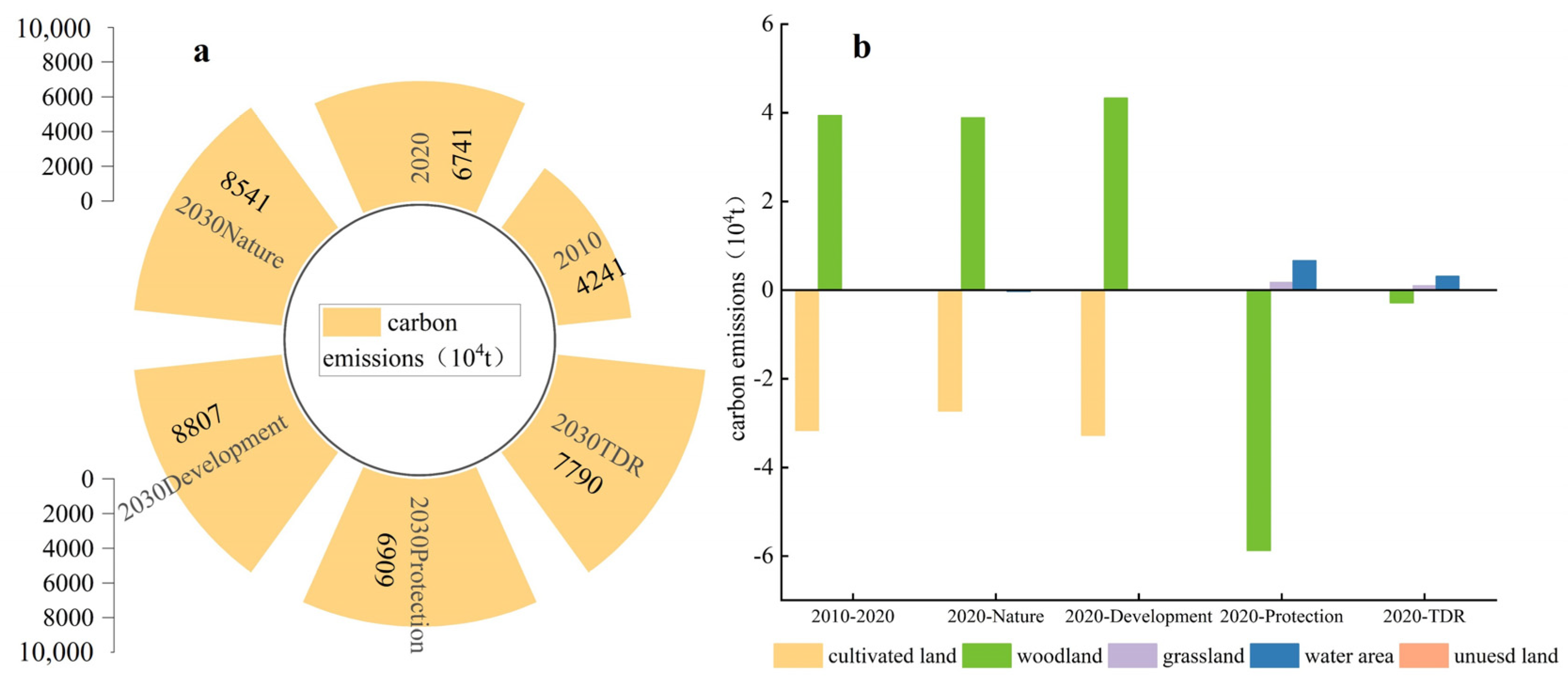
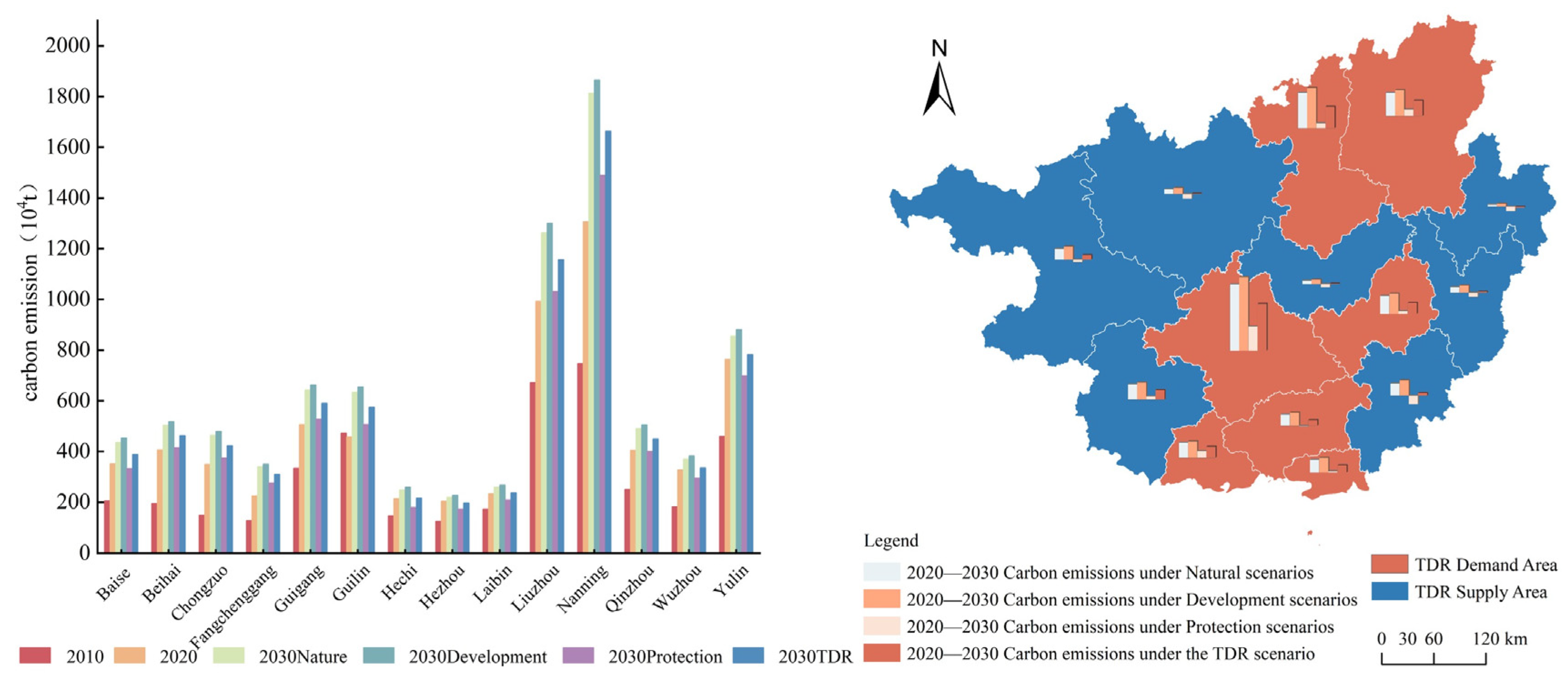
| Type | Data | Type | Source and Processing |
|---|---|---|---|
| Land-use data | LUCC | Grid 30 m | Center for Resource and Environmental Sciences and Data, Chinese Academy of Sciences |
| Drivers | Population, GDP, precipitation, temperature, soil | Grid 1 km | Center for Resource and Environmental Sciences and Data, Chinese Academy of Sciences |
| DEM, Slope | Grid 30 m | Geospatial Data Cloud, generated from DEM data | |
| Distance from city | Grid 1 km | Open Street Map | |
| Distance to roads (classified as primary, secondary, tertiary, quaternary, highway), distance to railroads, distance to rivers | Vector | National Geographic Information Resources Inventory Service System, obtained after ArcGIS Euclidean distance analysis processing | |
| Other data | Guangxi Nature Reserves | Vector | Center for Resource and Environmental Sciences and Data, Chinese Academy of Sciences |
| Energy Consumption Data | / | «China Energy Statistics Yearbook» | |
| GDP, Industry, Population Data | / | «Guangxi Zhuang Autonomous Region Statistical Yearbook» |
| Item | Category | Numerical Value |
|---|---|---|
| Direct carbon emission | Cultivated land (t·hm−2) | 0.422 |
| Forest land (t·hm−2) | −0.644 | |
| Grassland (t·hm−2) | −0.021 | |
| Water area (t·hm−2) | −0.253 | |
| Unutilized land (t·hm−2) | −0.005 | |
| Indirect carbon emissions | Raw coal (t·t−1) | 0.7559 |
| Washed coal (t·t−1) | 0.7559 | |
| Coke (t·t−1) | 0.855 | |
| Crude oil (t·t−1) | 0.5857 | |
| Gasoline (t·t−1) | 0.5538 | |
| Kerosene (t·t−1) | 0.5714 | |
| Diesel oil (t·t−1) | 0.5921 | |
| Fuel oil (t·t−1) | 0.6185 | |
| Liquefied petroleum gas (t·t−1) | 0.5042 | |
| Natural gas (t·t−1) | 0.4483 |
| Year | Raw Coal | Washed Coal | Coke | Crude Oil | Gasoline | Kerosene | Diesel Oil | Fuel Oil | Liquefied Petroleum Gas | Natural Gas |
|---|---|---|---|---|---|---|---|---|---|---|
| 2010 | 56.33 | 5.76 | 6.82 | 3.96 | 2.48 | 0.03 | 4.22 | 0.35 | 1.05 | 0.02 |
| 2020 | 77.88 | 7.68 | 14.12 | 12.76 | 2.86 | 0.20 | 4.35 | 0.20 | 0.95 | 0.32 |
| 2030 | 84.50 | 8.40 | 22.25 | 17.64 | 2.93 | 0.49 | 4.93 | 0.25 | 1.05 | 1.08 |
| Year | Direct Carbon Emissions | Direct Carbon Emissions | Indirect Carbon Emissions | Carbon Emissions | ||||
|---|---|---|---|---|---|---|---|---|
| Cultivated Land | Woodland | Grassland | Waters | Unutilized Land | ||||
| 2010 | 2.17 | −10.02 | −0.04 | −0.09 | −0.01 | −7.99 | 50.39 | 42.41 |
| 2020 | 2.14 | −9.98 | −0.04 | −0.09 | −0.01 | −7.97 | 75.39 | 67.42 |
| 2030 Nature | 2.11 | −9.94 | −0.04 | −0.09 | −0.01 | −7.96 | 93.37 | 85.41 |
| 2030 Development | 2.10 | −9.93 | −0.04 | −0.09 | −0.01 | −7.96 | 96.04 | 88.08 |
| 2030 Protection | 2.14 | −10.04 | −0.04 | −0.09 | −0.01 | −8.02 | 77.12 | 69.09 |
| 2030 TDR | 2.14 | −9.98 | −0.04 | −0.09 | −0.01 | −7.97 | 85.87 | 77.90 |
Disclaimer/Publisher’s Note: The statements, opinions and data contained in all publications are solely those of the individual author(s) and contributor(s) and not of MDPI and/or the editor(s). MDPI and/or the editor(s) disclaim responsibility for any injury to people or property resulting from any ideas, methods, instructions or products referred to in the content. |
© 2025 by the authors. Licensee MDPI, Basel, Switzerland. This article is an open access article distributed under the terms and conditions of the Creative Commons Attribution (CC BY) license (https://creativecommons.org/licenses/by/4.0/).
Share and Cite
Zhang, M.; Tang, Y.; Liu, J.; Chen, Z.; Kang, Q. Increase or Decrease? The Impact of Land Development Rights Transfer on Regional Carbon Emission Governance. Sustainability 2025, 17, 3072. https://doi.org/10.3390/su17073072
Zhang M, Tang Y, Liu J, Chen Z, Kang Q. Increase or Decrease? The Impact of Land Development Rights Transfer on Regional Carbon Emission Governance. Sustainability. 2025; 17(7):3072. https://doi.org/10.3390/su17073072
Chicago/Turabian StyleZhang, Mengmeng, Yi Tang, Junzhu Liu, Zhoupeng Chen, and Qing Kang. 2025. "Increase or Decrease? The Impact of Land Development Rights Transfer on Regional Carbon Emission Governance" Sustainability 17, no. 7: 3072. https://doi.org/10.3390/su17073072
APA StyleZhang, M., Tang, Y., Liu, J., Chen, Z., & Kang, Q. (2025). Increase or Decrease? The Impact of Land Development Rights Transfer on Regional Carbon Emission Governance. Sustainability, 17(7), 3072. https://doi.org/10.3390/su17073072





